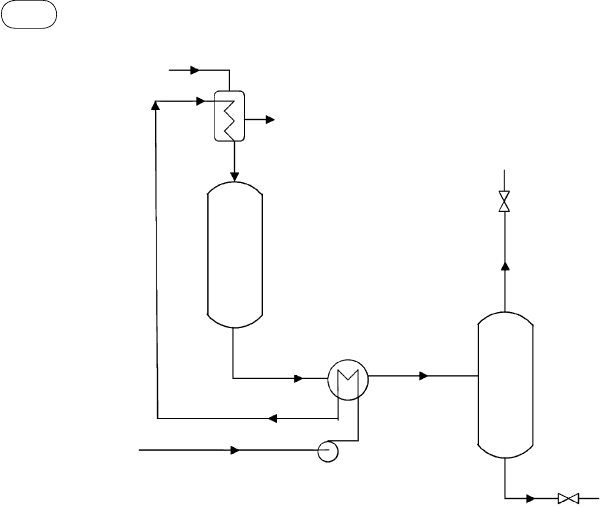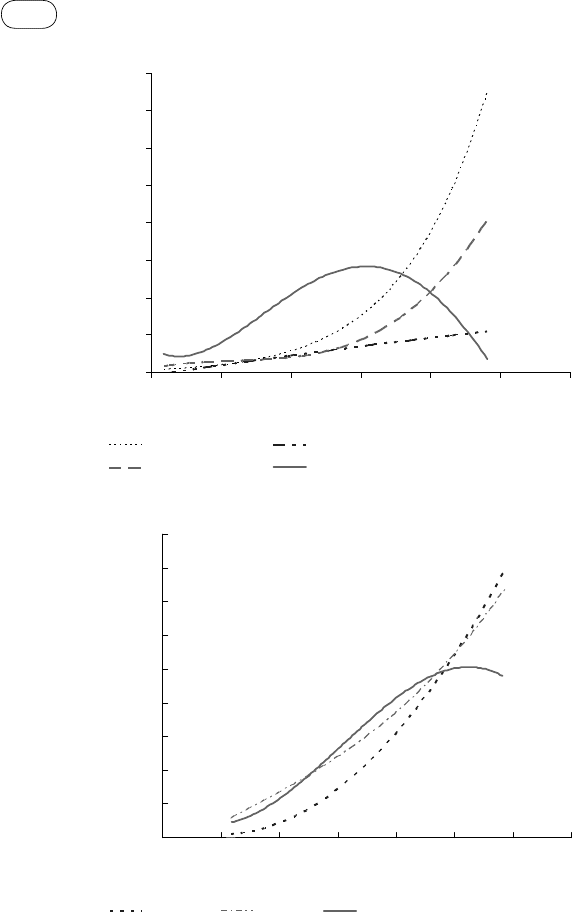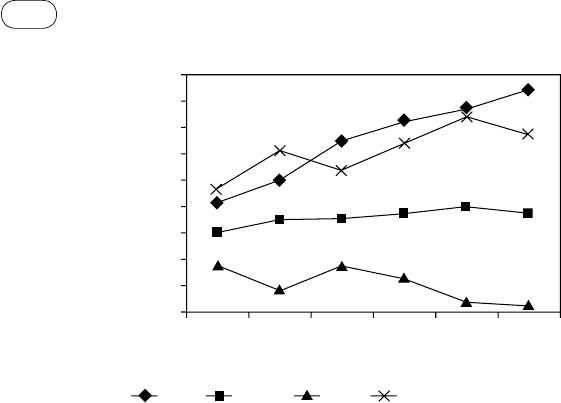Basu P. Biomass Gasification and Pyrolysis: Practical Design and Theory
Подождите немного. Документ загружается.


237
7.3 Biomass Conversion in SCW
The product gas of SCWG automatically separates from the liquid contain-
ing tarry materials and char if any.
7.3 BIomaSS converSIon In ScW
There are three major routes for SCW-based conversion of biomass into energy
as follows:
Liquefaction: Formation of liquid fuels above critical pressure (22.1 MPa)
but near critical temperature (300–400 °C).
Gasification to CH
4
: Conversion in SCW in a low-temperature range (350–
500 °C) in the presence of a catalyst.
Gasification to H
2
: Conversion in SCW with or without catalysts at higher
(>600 °C) temperatures.
Here we discuss only the last two gasification options.
7.3.1 Gasification
Supercritical biomass gasification takes place typically at around 500 to
750 °C in the absence of catalysts, and at an even lower (350–500 °C) tempera-
ture with catalysts. The biomass decomposes into char, tar, gas, or other inter-
mediate compounds, which are reformed into gases like CO, CO
2
, CH
4
, and
H
2
. The process is schematically shown in Figure 7.4. If the biomass is repre-
sented by the general formula C
6
H
12
O
6
, the gasification process may be described
by the following overall reaction:
m n w x y zC H O H O H CH CO CO
6 12 6 2 2 4 2
+ → + + + (7.3)
Gasification in SCW involves, among other reactions, hydrolysis and oxida-
tion reactions. A brief description of these reactions follows.
7.3.2 Hydrolysis
Hydrolysis (meaning “splitting with water”) is the reaction of an organic com-
pound with water. Here, a bond of an organic molecule is broken, and the water
molecule is also broken into [H
+
] and [OH
−
]. The organic molecules are cleaved
into two parts by the water molecule: One part gains the [H
+
] ion; the other
Biomass
Thermal
decomposition
Reforming
Char
Tar
Gas, etc.
CO
CO
2
CH
4
H
2
FIGure 7.4 Biomass gasification process.

238
chapter
|
7 Hydrothermal Gasification of Biomass
part, the [OH
−
] ion. Hydrolysis reactions are generally catalyzed by acid or base
catalysts. Water near its critical point (at high temperature and pressure) has a
high ion product, so the hydrolysis reaction is catalyzed by the water itself.
A simplified representation of the reaction scheme is shown in Figure 7.5(a)
with polyethylene terephthalate (PET) as an example. The hydrolysis of PET
into terephthalic acid and ethylene glycol in SCW is a better option than other
reactions (e.g., methanolysis or glycololysis) because it does not require sol-
vents and catalysts like others. Here, water near its critical point is used to
accomplish this reaction in a shorter time. Additionally, SCW avoids the need
to recover and dispose of external solvents or catalysts. Figure 7.5(b) is a
photograph of polyethylene terephthalate in ordinary water before and after
hydrolysis in SCW into fine particles of teraphthalic acid in ethylene glycol
solution.
(b)
(a)
Terephthalic acid
Ethylene glycol Terephthalic acid
Hydrolysis
PET (polyethylene terephthalate)
H
2
O H
2
O H
2
O
O C C C C
O
O
O O O
O
CH
2
CH
2
CH
2
CH
2
O
HO C
O O O O
C OH+HO CH
2
CH
2
CH
2
CH
2
OH+HO C C OH+HO OH
H
2
O
Ethylene glycol
FIGure 7.5 (a) Hydrolysis of PET in supercritical water; photograph of PET pellets in subcriti-
cal water and (b) that of its product in SCW after hydrolysis. (Source: Adapted from Kobe Steel.)

239
7.3 Biomass Conversion in SCW
7.3.3 Supercritical Water oxidation
Supercritical water that exhibits complete miscibility with oxygen is a homo-
geneous reaction medium for the oxidation of organic molecules. This feature
of SCW allows oxidation of harmful or toxic substances at low temperature in
a process known as supercritical water oxidation (SCWO) or cold combustion.
In a typical SCWO unit, the entire mixture (water, oxygen, and waste) remains
as a single fluid phase with no interphase transport limitations. This allows very
rapid and complete (>99.9%) oxidation of the organic wastes to harmless
lower-molecular-weight compounds like H
2
O, N
2
, and CO
2
. Unlike thermal
incineration, SCWO produces toxic by-products such as dioxin. This method
of waste treatment is especially attractive for highly dilute toxic wastes in water.
One important shortcoming of this process is the production of highly cor-
rosive liquid effluents because chlorine, sulfur, and phosphorous, if present in
the waste, are converted into their corresponding acids (Serani et al., 2008).
The destruction of polychlorinated biphenyls (PCBs) in supercritical water,
producing carbon dioxide and hydrochloric acid, may be represented by the
following simple reaction:
C H Cl PCB O H O CO HCl
12 10 2 2 2
19 2 5 12
−
( )
+ +
( )
+ −
( )
= +
m m
m m m (7.4)
Conventional thermal incineration uses very high temperature to destroy by-
products like dioxin, which results in the production of another pollutant, NOx.
This is not the case with SCWO owing to its low-temperature operation (450–
600 °C).
7.3.4 Scheme of an ScWG plant
A typical SCWG plant includes the following key components:
Feedstock pumping system
Feed preheater
Gasifier/reactor
Heat-recovery (product-cooling) exchanger
Gas–liquid separator
Optional product-upgrading equipment
The feed preheating system is very elaborate and accounts for the majority
(~60%) of the capital investment in an SCW gasification plant.
Figure 7.6 describes the SCWG process using the example of an SCWG
plant for gasifying sewage sludge. Biomass is made into a slurry for feeding.
It is then pumped to the required supercritical pressure. Alternatively, water
may be pressurized separately and the biomass fed into it. In any case, the
feedstock needs to be heated to the designed inlet temperature for the gasifier,
which must be above the critical temperature and well above the designed
gasification temperature because the enthalpy of the water provides the energy

240
chapter
|
7 Hydrothermal Gasification of Biomass
required for the endothermic gasification reactions. This temperature is a criti-
cal design parameter.
The sensible heat of the product of gasification may be partially recovered
in a waste heat-recovery exchanger and used for partial preheating of the feed
(Figure 7.6). For complete preheating, additional heat may be obtained from
one of the following:
Externally fired heater (Figure 7.6)
Burning of a part of the fuel gas produced to supplement the external fuel
Controlled burning of unconverted char in the reactor system (refer to
Figure 7.12 later in chapter)
After gasification, the product is first cooled in the waste heat-recovery unit.
Thereafter, it cools to room temperature in a separate heat exchanger by giving
off heat to an external coolant.
The next step involves separation of the reaction products. The solubility
of hydrogen and methane in water at low temperature but high pressure is
considerably low, so they are separated from the water after cooling while
the carbon dioxide, because of its high solubility in water, remains in the
liquid phase. For complete separation of CO
2
, the gas may be scrubbed with
additional water (refer to Figure 7.14 later in chapter). The gaseous hydrogen
is separated from the methane in a pressure swing adsorber. The CO
2
-rich liquid
is depressurized to the atmospheric pressure, separating the carbon dioxide
from the water and unconverted salts.
Combustion air
plus CH
4
Flue gas
Product
gas
Phase
separator
Clean
water
SCW
reactor
HET
exchanger
Product
Waste effluent pump
FIG
ure
7.6
Schematic of a pilot plant for supercritical water gasification of biomass.

241
7.4 Effect of Operating Parameters on SCW Gasification
7.4 eFFect oF operatInG parameterS
on
S
cW
Ga
SIFIcatIon
The product of gasification is defined by its yield and composition, which are
influenced by a number of gasifier design and operating parameters. For proper
design and operation of an SCW gasifier, a good understanding of the influence
of the following parameters is important:
Reactor temperature
Catalyst use
Residence time in the reactor
Solid concentration in the feed
Heating rate
Feed particle size
Reactor pressure
Reactor type
7.4.1 reactor temperature
Temperature has an important effect on the conversion, the product distribution,
and the energy efficiency of an SCW gasifier, which typically operates at a
maximum temperature of nearly 600 °C. The overall carbon conversion
increases with temperature; at higher temperatures hydrogen yield is higher
while methane yield is lower. Figure 7.7 shows the temperature dependence of
gasification efficiency and product distribution in a reactor operated at 28 MPa
(30-s residence, 0.6-M glucose) (Lee et
al., 2002). We see that the hydrogen
yield increases exponentially above 600 °C, while the CO yield, which rises
gently with temperature, begins to drop above 600 °C owing to the start of the
shift reaction (Eq. 5.52).
Gasification efficiency is measured in terms of hydrogen or carbon in the
gaseous phase as a fraction of that in the original biomass. Carbon conversion
efficiency increases continually with temperature, reaching close to 100%
above 700 °C. Hydrogen conversion efficiency (the fraction of hydrogen in
glucose converted into gas) also increases with temperature. It appears strange
that at 740 °C, the hydrogen conversion efficiency exceeds 100%, reaching
158%. This clearly demonstrates that the extra hydrogen comes from the water,
confirming that water is indeed a reactant in the SCWG process as well as a
reaction medium.
Hydrothermal gasification of biomass has been divided into three broad
temperature categories: high, medium, and low with their desired products
(Peterson et al., 2008). Table 7.2 shows that the first group targets production
of hydrogen at a relatively high temperature (>500 °C); the second targets
production of methane at just above the critical temperature (~374.29 °C) but
below 500 °C; and the third gasifies at subcritical temperature, using only
simple organic compounds as its feedstock. The last two groups, because of
their low-temperature operation, need catalysts for reactions.

242
chapter
|
7 Hydrothermal Gasification of Biomass
0
1
2
3
4
5
6
7
8
Temperature (°C)
(a)
(b)
Gas yield (mol of gas/mol of glucose)
Hydrogen
Methane
Carbon dioxide Carbon monoxide
0
20
40
60
80
100
120
140
160
180
500 550 600 650 700 750 800
450 500 550 600 650 700 750 800
Temperature (°C)
Gasification efficiency (%)
Hydrogen
Carbon
Oxygen
FIGure 7.7 Effect of temperature on gas yield (a), and effect of temperature on gasification
efficiency (b). (Source: Adapted from Lee et
al., 2002.)

243
7.4 Effect of Operating Parameters on SCW Gasification
7.4.2 catalysts
An effective degradation of biomass and the gasification of intermediate prod-
ucts of thermal degradation into lower-molecular-weight gases like hydrogen
require the SCW reactor to operate in the high-temperature range (>600 °C).
The higher the temperature, the better the conversion, especially for production
of hydrogen, but the lower the SCW’s energy efficiency. A lower gasification
temperature is therefore desirable for higher thermodynamic efficiency of the
process.
Catalysts help gasify the biomass at lower temperatures, thereby retaining,
at the same time, high conversion and high thermal efficiency. Additionally,
some catalysts also help gasification of difficult items like the lignin in biomass.
Watanabe et al. (2003) noted that the hydrogen yield from lignin at 400 °C and
30
MPa is doubled when a metal oxide (ZrO
2
) catalyst is used in the SCW. The
yield increases four times with a base catalyst (NaOH) compared to gasification
without a catalyst. The three principal types of catalyst used so far for SCW
gasification are: (1) alkali, (2) metal, and (3) carbon-based.
An important positive effect of catalysts in SCWG is the reduction in
required gasification temperature for a given yield. Minowa et al. (1998) noted
a significant reduction in unconverted char while gasifying cellulose with an
Na
2
CO
3
catalyst at 380 °C. Base catalysts (e.g., NaOH, KOH) offer better
performance, but they are difficult to recover from the effluent. Some alkalis
(e.g., NaOH, KOH, Na
2
CO
3
, K
2
CO
3
, and Ca(OH)
2
) are also used. They, too,
are difficult to recover.
The special advantage of metal oxide catalysts is that they can be recovered,
regenerated, and reused. Commercially available nickel-based catalysts are
effective in SCW biomass gasification. Among them, Ni/MgO (nickel sup-
ported on an MgO catalyst) shows high catalytic activity, especially for biomass
(Minowa et
al., 1998).
Metal catalysts have a severe corrosion effect at the temperatures needed to
secure high yields of hydrogen. To overcome this problem, Antal et
al. (2000)
used carbon (e.g., coal-activated and coconut shell–activated carbon and maca-
damia shell and spruce wood charcoal). The carbon catalysts resulted in high
yields of gas without tar formation.
TABLE 7.2 Hydrothermal Gasification Temperature Categories
Based on Target Product (T
c
~374.29 °C)
Temperature (°C) Catalyst Target Product
High (>500)
Not needed Hydrogen-rich gas
Medium (T
c
– 500)
Needed Methane-rich gas
Low (<T
c
)
Essential Other gases of smaller organic molecules

244
chapter
|
7 Hydrothermal Gasification of Biomass
7.4.3 residence time
A longer residence for the reactants in the reactor gives a better yield. Lu et al.
(2006) experimented with 2% (by weight) sawdust and 2% carboxymethyl
cellulose (CMC) in a flow reactor at 650 °C and 25
MPa. Mettanant et
al.
(2009) experimented with 2% rice husk in a batch reactor under the same
conditions. Both found a steady increase in hydrogen and a moderate increase
in methane (Figure 7.8) when the residence time was increased by three times
and six times, respectively. Total organic carbon in the liquid product decreases
with residence time, whereas carbon and hydrocarbon gasification efficiencies
increase. This implies that a longer residence time is favorable for SCW biomass
gasification. The optimum residence time, beyond which no further improve-
ment in conversion efficiency is possible, depends on several factors. At a
higher temperature, the residence time required for a given conversion is
shorter.
7.4.4 Solid concentration in Feedstock
Unlike in other gasification methods, solids in the feed have an important effect
on the gasification in supercritical water. Thermodynamic calculations suggest
that the conversion of carbon to gases in SCW declines rapidly when the solid
content in a liquid feed exceeds 50% (Prins et
al., 2005), but experimental
results show this to occur for a much lower concentration. Experimental
data (Mettanant et al., 2009; Schmieder et al., 2000) indicate that gasification
18
16
14
12
10
8
6
4
2
0
10 20
Gas yield (mol/kg)
30 40
Residence time (min)
H
2
CH
4
CO CO
2
50 60
FIG
ure
7.8
Effect of residence time on the gasification of 2% rice husk in supercritical water
at 650 °C and 30
MPa in a batch reactor.

245
7.4 Effect of Operating Parameters on SCW Gasification
efficiency starts to decline when the solid concentration exceeds a value as low
as 2%.
Table 7.3 presents data (Mozaffarian et
al., 2004) that show the effect of
solid content in feed. Although experimental conditions and feedstock vary, we
can broadly classify these results into groups of low, medium, and high solid
feedstock. For a lower feed concentration (<2%), carbon conversion efficiency
is in the range 100 to 92% and reduces to 60 to 90% for an intermediate con-
centration (2–10%) and to 68 to 80% for a >10% concentration. An SCW
gasifier thus needs a very low solid concentration in the feed for high carbon
conversion efficiency. This requires higher pumping costs and liquid effluent
disposal, which may be a major impediment in commercialization of SCW
gasification.
The reactor type also influences how solid concentration affects gasifi
-
cation efficiency. For example, Kruse et
al. (2003) noted that a stirred reactor
shows opposite results—that is, higher gasification efficiency at higher solid
content (1.8 to 5.4%) in feed. This contrasts with data from Schmieder
et
al. (2000) from tumbling and tubular reactors that indicate a decrease in
gasification efficiency with solid content (0.2–0.6
M). In stirred reactors,
reactants are very well mixed, resulting in a heating rate that is faster than
achieved in other reactor types. This may be the explanation for the higher
gasification efficiency where there is a higher solid content. The exact reason
for this decrease is not clear and is a major issue in the development of com-
mercial SCW gasifiers. Catalysts, high gasification temperatures, and high
heating rates can avoid the drop in conversion of a high-solid-content feedstock
(Lu et
al., 2006).
7.4.5 Heating rate
Limited data obtained by Sinag et al. (2004) suggest that at a higher heating
rate the yield of hydrogen, methane, and carbon dioxide increases while that
of carbon monoxide decreases. Further investigation is needed to elucidate this
point.
7.4.6 Feed particle Size
The effect of biomass particle size is not well researched. With limited data,
Lu et
al. (2006) showed that smaller particles result in a slightly improved
hydrogen yield and higher gasification efficiency. However, Mettanant et
al.
(2009) did not observe any effect when they varied the size of rice husk par-
ticles in the range of 1.25 to 0.5
mm. Even if the size effect is confirmed with
further data, it remains to be seen if the extra energy required for grinding is
worth the improvement.

TABLE 7.3 Effect of Solid Content in Feed and Other Operating Parameters on Gasification
Investigators
C < 2 wt.% 2 < C < 10 wt.% C > 10 wt.%
Holgate, 1995 Yu, 1993 Kruse, 1999 Hao, 2003 Xu, 1996 Kruse, 2003 Yu, 1993 Xu, 1996
Feedstock Glucose Glucose Wood Glucose Formic acid Baby food Glucose Glucose
Feed concentration
in SCW (%/weight)
0.01 1.8 1 7.2 2.8 5.4 14.4 22
Pressure (bar) 246 345 350 250 345 300 345 345
Temperature (°C) 600 600 450 650 600 500 600 600
Reactor type Flow reactor Tubular flow
reactor
Autoclave Tubular flow
reactor (9
mm)
Tubular flow
reactor
SCTR Tubular flow
reactor
Tubular flow
reactor
Residence time (s) 6 34 7200 210 34 300 34 34
Carbon conversion
efficiency (%)
100 90 91.8 89.6 93 60 68 80
Gas composition:
H
2
61.3 61.6 28.9 21.5 49.2 44 25 11
CO
2
36.8 29 48.4 35.5 48.1 41 16.6 5.7
CO — 2 3.3 18.3 1.7 0.4 41.6 62.3
CH
4
1.8 7.2 19 15.8 1 14.6 16.7 16.5
C
2,3
- - 5.3 - - - 4.5
C = concentration of solid in feed
Source: Compiled from Mozaffarian et
al., 2004.
